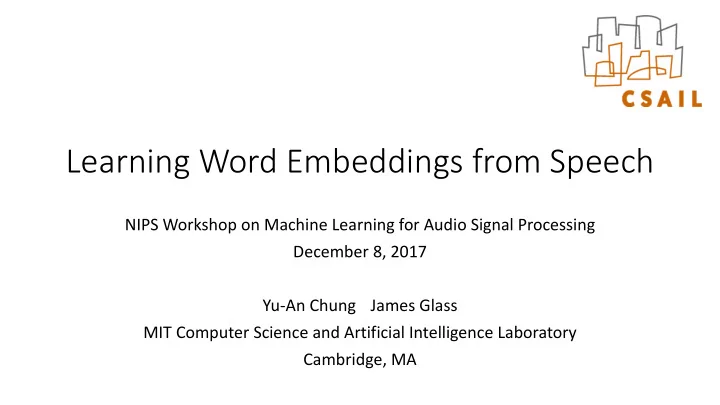

Learning Word Embeddings from Speech NIPS Workshop on Machine Learning for Audio Signal Processing December 8, 2017 Yu-An Chung James Glass MIT Computer Science and Artificial Intelligence Laboratory Cambridge, MA
Outline • Motivation • Proposed Approach • Experiment • Conclusion
Motivation • GloVe and word2vec transform words into fixed dimensional vectors. • Obtained by unsupervised learning from co-occurrences information in the text • Contain semantic information about the word • Humans learn to speak before they can read or write. • Machines can learn semantic word embeddings from raw text. Can machines learn semantic word embeddings from speech as well?
Text (written language) Speech (spoken language) Audio signal processing is currently undergoing a paradigm change, where data-driven machine learning is replacing hand-crafted feature design. This has led some to ask whether audio signal processing is still useful in the era of machine learning. Input Input Learning system Learning system such as GloVe and word2vec our goal Output Output Word embeddings Word embeddings audio audio signal signal processing processing … … learning learning
We aim to learn embeddings that capture semantic information rather Acoustic Word Embeddings than acoustic-phonetic structure! • Also learn fixed-length vector representations (embeddings) from speech • Audio segments that sound alike would have embeddings nearby in the space. • Capture phonetic structure Acoustic Semantics Man Sing King King Sing Man References: [1] Multi-view recurrent neural acoustic word embeddings. He et al., ICLR 2017 [2] Discriminative acoustic word embeddings: Recurrent neural network-based approaches. Settle and Livescu, SLT 2016 [3] Audio word2vec: Unsupervised learning of audio segment representations using sequence-to-sequence autoencoder. Chung et al., Interspeech 2016 [4] Deep convolutional acoustic word embeddings using word-pair side information. Kamper et al., ICASSP 2016 [5] Word embeddings for speech recognition. Bengio and Heigold, Interspeech 2014
Outline • Motivation • Proposed Approach • Experiment • Conclusion
Our approach is inspired by word2vec (skip-gram) All represented as one-hot Text x " x "#$ x "#% x "&% x "&$ x "#$ x "#% x "&% x "&$ Audio signal processing is currently undergoing a paradigm change … Window size = 2 Softmax probability estimator Word embedding of x " Single layer fully-connected neural network (linear) x " represented as one-hot x "
Word2Vec (skip-gram) for text Our approach x " x "#$ x "#% x "&% x "&$ Audio signal processing is currently Speech Text undergoing a paradigm change … x " x "&$ x "&% x "#% x "#$ All represented as a sequence [0, 0, 0, 1, 0, …] [0, 0, 0, 0, 1, …] [1, 0, 0, 0, 0, …] [0, 1, 0, 0, 0, …] of acoustic feature vectors x "#% x "&% x "&$ x "&% x "#$ x "#$ x "&$ x "#% Softmax probability Another RNN as estimator decoder Single layer fully-connected Variable-length sequence? neural network RNN (acts as an encoder) Represented as a sequence x " x " [0, 0, 1, 0, 0, …] of acoustic feature vectors such as MFCCs
Speech x "#% = … x "#% x "&% x " … Shared Here window size = 1 Learned word embedding of x " Decoder RNN … Projection … Encoder RNN … Projection … … … x " = x "&% =
Outline • Motivation • Proposed Approach • Experiment • Conclusion
Corpus & Model Architecture • LibriSpeech - a large corpus of read English speech (500 hours) • Acoustic features consisted of 13-dim MFCCs produced every 10ms • Corpus was segmented via forced alignment • Word boundaries were used for training our model • Encoder RNN is a 3-layer LSTM with 300 hidden units (dim = 300) • Decoder RNN is a single-layer LSTM with 300 hidden units
Task: 13 word similarity benchmarks • The 13 benchmarks contain different numbers of pairs of English words that have been assigned similarity ratings by humans. • Each benchmark evaluate the word embeddings in terms of different aspects, e.g., • RG-65 and MC-30 focus on nouns • YC-130 and SimVerb-3500 focus on verbs • Rare-Word focuses on rare words • Spearman’s rank correlation coefficient 𝜍 between the rankings produced by the model against the human rankings (the higher the better) • Embeddings representing the audio segments of the same word were averaged to obtain one single 300-dim vector/word
Experimental Results Our model
t-SNE Visualization bike machine car gear money cash currency title character role
Impressive, but why still worse than GloVe? 1. Different speech and text training data (LibriSpeech vs. Wikipedia) 2. Inherent variability in speech production - unlike textual data, every instance of any spoken word ever uttered is different: • Different speakers • Different speaking styles • Environmental conditions • Just name a few of the major influences on a speech recording
Outline • Motivation • Proposed Approach • Experiment • Conclusion
Conclusion • We proposed a model for learning semantic word embeddings from speech: • Mimics the architecture of the textual skip-gram word2vec • Uses two RNNs to handle variable-length input and output sequences • Showed impressive results (not too worse than GloVe trained on Wikipedia) on word similarity tasks • Verified that machines are capable of learning semantics word embeddings from speech!
Future Works 1. Assuming perfect word boundaries is unrealistic - try train the model on very likely imperfect segments obtained by existing segmentation methods 2. Overcome speech recording issues - try remove the speaker information 3. Compare with word2vec/GloVe trained on LibriSpeech transcriptions 4. Evaluate the word embeddings on downstream applications - their effectiveness on real tasks is actually what we care
Thank you!
Recommend
More recommend